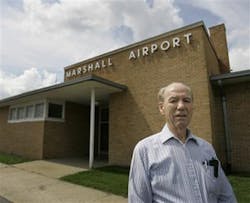Dan Silverthorn had just touched down when his single-engine Beech C23 jolted violently and careered off the runway on its belly in a shower of sparks.
From the air, the veteran pilot couldn't tell that the runway at Higginsville, Mo., had a fresh layer of pavement that ended abruptly, creating an 8-inch ledge that ripped the landing gear from his plane like the pull-tab from a sardine can.
"I never really had time to get scared," Silverthorn said. "It happened so fast."
The Missouri businessman's experience last October is not uncommon. The National Transportation Safety Board has documented at least 15 similar occurrences since 1992 at airports where runway or taxiway construction projects were under way or newly completed. Silverthorn and his daughter ended up safe in a grass field, but others weren't as fortunate.
The latest involved Comair Flight 5191 and its attempted takeoff early on the morning of Aug. 27 at Lexington's Blue Grass Airport.
A repaving project had changed the taxiway route just one week earlier and is now one of several factors federal investigators are looking into as possible causes of the fiery crash that killed 49 of the 50 people aboard.
The pilots of the Atlanta-bound regional plane took a wrong turn onto a runway that was much too short for the twin-engine jet, even though conversations with the air traffic control tower indicated they thought they were heading for the airport's main runway - one almost twice as long. Data recordings from the plane show they continued to accelerate until the plane clipped trees and crashed in a nearby field.
The only survivor was the first officer, James Polehinke, who remained hospitalized Monday.
The deadliest crash recorded by the NTSB at an airport construction site was in Taiwan in October 2000, when the pilots of a Los Angeles-bound Boeing 747-400 turned onto the wrong runway and plowed into construction debris, killing 83 passengers.
Jeffrey Roy, a retired Federal Aviation Administration investigator now working as an aviation safety consultant in Colorado, said that considering the large number of runway and taxiway construction projects each year, such crashes are relatively rare, especially those in which pilots end up on the wrong runway.
"I don't know of any crashes where construction has been considered the primary factor, because there are so many other procedures that should be followed by the crew to verify their position," Roy said.
Pilots can avoid construction zones if they take advantage of "notices to airmen" alerts distributed about airport conditions.
"Each FAA region probably has multiple construction projects going on at any time at small and large airports," Roy said. "It's a fairly common thing that pilots need to be aware of."
In the Lexington crash, recorded conversations between the cockpit and control tower indicated Captain Jeffrey Clay and First Officer James Polehinke intended to use the airport's 7,000-foot runway for commercial aircraft, investigators said. Instead, they turned onto the 3,500-foot runway and attempted to take off. The plane hit a fence and trees and crashed on an adjoining farm.
The pilots were familiar with Blue Grass Airport. Clay had been there six times in the past two years, and Polehinke had been there 10 times in that period.
However, neither had been to the airport since the runway repaving project was completed. The construction project extended the airport's main runway by 600 feet at each end. It also redirected the taxiway, blocking the previous route with a white- and orange-striped barricade with flashing lights on top and creating a sharper turn right near the start of the shorter runway.
Blue Grass Airport Executive Director Michael Gobb had touted the importance of the project in press statements, saying the additional runway length "is intended to provide an extra margin of safety for arriving and departing aircraft."
In the case of Silverthorn's belly landing, the NTSB investigation noted that he touched down on an unfinished portion of a runway extension. There were no markings to show the end of new pavement.
The agency cited as probable causes the airport's failure to properly mark the runway project - and the pilot's failure to obtain the "notices to airmen" alert.
Silverthorn said he was thankful that he and his daughter were able to walk away from the crash uninjured. "I hadn't been to that airport in about six months," he said. "It was such a surprising thing."
News stories provided by third parties are not edited by "Site Publication" staff. For suggestions and comments, please click the Contact link at the bottom of this page.






